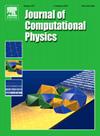SNF-ROM: Projection-based nonlinear reduced order modeling with smooth neural fields
IF 3.8
2区 物理与天体物理
Q2 COMPUTER SCIENCE, INTERDISCIPLINARY APPLICATIONS
引用次数: 0
Abstract
Reduced order modeling lowers the computational cost of solving PDEs by learning a low-dimensional spatial representation from data and dynamically evolving these representations using manifold projections of the governing equations. The commonly used linear subspace reduced-order models (ROMs) are often suboptimal for problems with a slow decay of Kolmogorov n-width, such as advection-dominated fluid flows at high Reynolds numbers. There has been a growing interest in nonlinear ROMs that use state-of-the-art representation learning techniques to accurately capture such phenomena with fewer degrees of freedom. We propose smooth neural field ROM (SNF-ROM), a nonlinear reduced order modeling framework that combines grid-free reduced representations with Galerkin projection. The SNF-ROM architecture constrains the learned ROM trajectories to a smoothly varying path, which proves beneficial in the dynamics evaluation when the reduced manifold is traversed in accordance with the governing PDEs. Furthermore, we devise robust regularization schemes to ensure the learned neural fields are smooth and differentiable. This allows us to compute physics-based dynamics of the reduced system nonintrusively with automatic differentiation and evolve the reduced system with classical time-integrators. SNF-ROM leads to fast offline training as well as enhanced accuracy and stability during the online dynamics evaluation. Numerical experiments reveal that SNF-ROM is able to accelerate the full-order computation by up to 199×. We demonstrate the efficacy of SNF-ROM on a range of advection-dominated linear and nonlinear PDE problems where we consistently outperform state-of-the-art ROMs.
求助全文
约1分钟内获得全文
求助全文
来源期刊

Journal of Computational Physics
物理-计算机:跨学科应用
CiteScore
7.60
自引率
14.60%
发文量
763
审稿时长
5.8 months
期刊介绍:
Journal of Computational Physics thoroughly treats the computational aspects of physical problems, presenting techniques for the numerical solution of mathematical equations arising in all areas of physics. The journal seeks to emphasize methods that cross disciplinary boundaries.
The Journal of Computational Physics also publishes short notes of 4 pages or less (including figures, tables, and references but excluding title pages). Letters to the Editor commenting on articles already published in this Journal will also be considered. Neither notes nor letters should have an abstract.
 求助内容:
求助内容: 应助结果提醒方式:
应助结果提醒方式:


